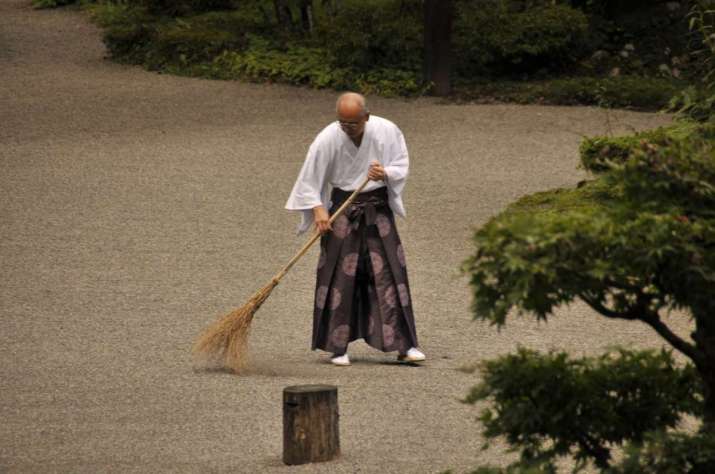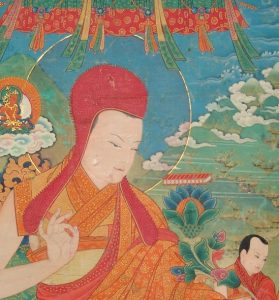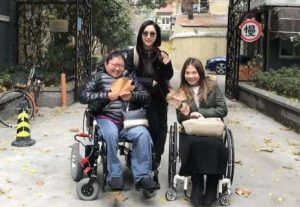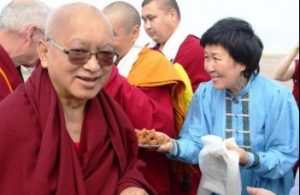
Japanese Buddhist monk Shoukei Matsumoto takes cleaning very seriously. In fact, he views it as an essential part of a healthy, positive life and Buddhist practice, going so far as to author a book on the subject that has become a bestseller in his native Japan and has recently been translated into English.
“A monk’s day begins with cleaning,” says Shoukei, who hails from Komyo-ji, a temple in Tokyo’s Kamiyacho neighborhood. “We do it to eliminate the gloom in our hearts.” (The Guardian)
Shoukei’s short book, in English titled A Monk’s Guide to a Clean House and Mind, draws on the ancient Buddhist tradition to explain how to bring the tranquillity and serenity of a Buddhist temple into one’s home through cleaning with intention: “It’s an ascetic practice to cultivate the mind,” Shoukei explains. (The Guardian)
As well as insights into Buddhist wisdom, the book offers practical suggestions for cleaning and observations on the wasteful habits encouraged by modern consumer society. “Cleaning practice, by which I mean the routines whereby we sweep, wipe, polish, wash, and tidy, is one step on this path toward inner peace,” he observes. “In Japanese Buddhism, we don’t separate a self from its environment, and cleaning expresses our respect for and sense of wholeness with the world that surrounds us.” (The Guardian)
At many temples in Japan, cleaning is a regular morning exercise, known as soji in Japanese, when the monks and members of the community participate in a 20-minute ritual of cleaning and tidying—sweeping hallways, raking paths, cleaning and drying dishes. All practiced with calm, silent, meditative intent that is an extension of one’s Buddhist practice.

“Of course, as a monk who is dedicated to spiritual life, I recommend Buddhist concepts and practices. But you don’t have to convert to a new religion to learn from it.” Shoukei observes in an essay for The Guardian newspaper. “Many people’s associations with the word ‘religion’ may include a set of rules to regulate people’s values and actions; the creation of an irrational transcendent entity; or the idea of a crutch for people who cannot think for themselves. In my view, though, a respectable religion does not exist to bind one’s values or actions. It is there to free people from the systems and standards that order society. In Japanese characters, the word ‘freedom’ is written as ‘caused by oneself.’” (The Guardian)
Indeed, the practice also recalls the Buddhist fable of Suddhipanthaka, one of the Buddha’s disciples. Although he was known to be a righteous person, he was perhaps the least intelligent of the disciples, and had great difficulty understanding the Buddha’s teachings, yet was able to attain enlightenment through the simple act of sweeping the ground.*
Shoukei emphasizes that the practice of ritualized cleaning is related discarding illusions and ignorance and the Buddhist understanding of non-self (Skt. anatman). He notes that what we view as our personalities are merely illusions created by our egos: “The characters for ‘human being’ in Japanese mean ‘person’ and ‘between.’ Human being is ‘a person in between.’ Thus, you as a human being only exist through your relations with others—people such as friends, colleagues, and family,” he explains. “You as a person have some particular words, facial expressions and behaviors, but these arise only through your interaction and connections with other people. This is the Buddhist concept “en” or interdependence.” (The Guardian)

Shoukei, who was ordained in 2003 in Jodo Shinshu, a school of Pure Land Buddhism, is also the founder of Virtual Temple “HIGANJI,” one of the most popular websites for Buddhists in Japan. He has published more than five books in Japanese, some of which have been translated into other languages. He was nominated as a member of Young Global Leaders 2013 at the World Economic Forum in Davos.**
* Sweep and Clean (FGS Buddha Museum)
** MBA Monk Aims to Rejuvenate Japan’s Buddhist Temples (Buddhistdoor Global)
See more
Take it from me, a Buddhist monk: cleaning is good for you (The Guardian)
A Monk’s Guide to a Clean House and Mind review – Buddhist housekeeping (The Guardian)
Welcome to Komyoji Temple












